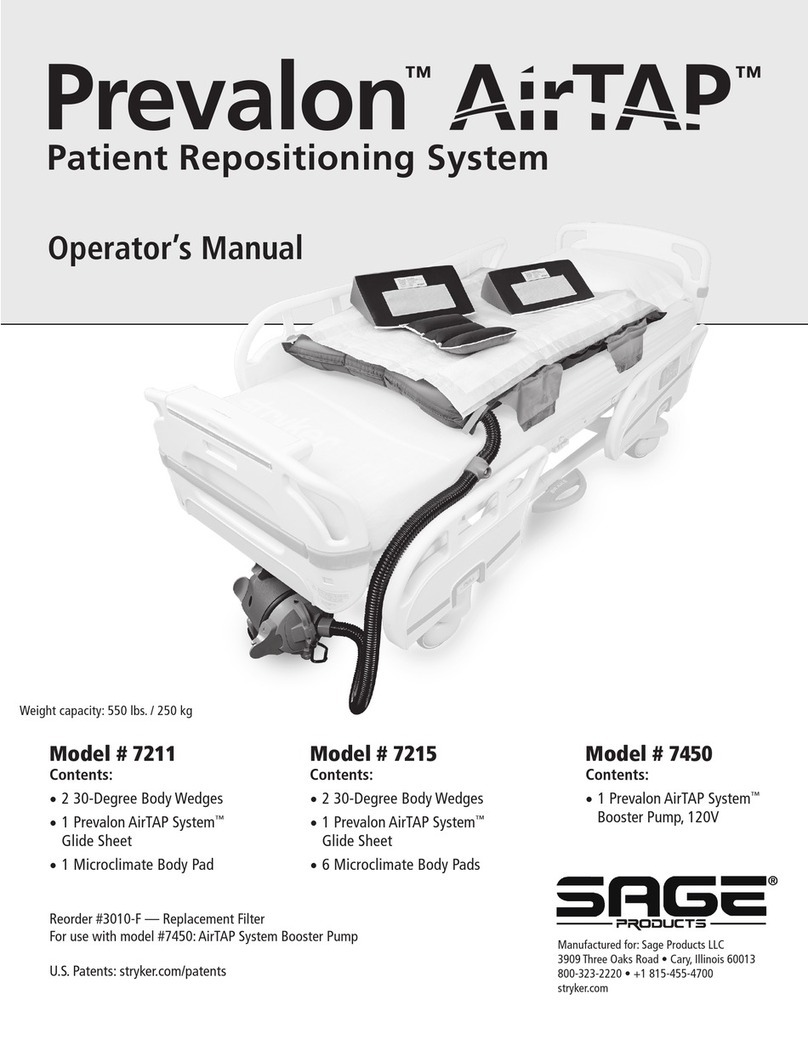
7
STEP 8
STEP 10
STEP 12
STEP13
TURNING THE PATIENT
1. Caregiver A and Caregiver B stand on opposite sides of the bed. Lock the bed
brakes and raise the bed rails. Place the bed in a horizontal position and at the
caregivers’ waist level.
2. Ensure the patient is centered on the Glide Sheet and the bed.
3. While closely observing the patient, push the Power Button on the Hose.
4. Allow the Glide Sheet to fully inflate.
iWARNING: Never leave the patient unattended while the Air Pump / Booster
Pump is powered on or the Glide Sheet is inflated.
5. Ensure the patient’s head and feet are supported.
6. Caregiver A lower the bed rail where the Wedges will be inserted.
7. Caregiver B use the Black Positioning Handles to secure the Glide Sheet.
8. Caregiver A grasp the Black Positioning Handle on the Glide Sheet and insert the
Anchor Wedge, tail first and with the black fabric facing up, so that the Anchor is
underneath the patient’s thighs.
9. Caregiver B pull the tail through until it is taut.
10. Caregiver A grasp the Black Positioning Handle on the Glide Sheet and insert the
Upper Wedge at least one hand width away from the Anchor Wedge.
11. The caregiver on the side of the bed where the Air Pump / Booster Pump is
connected pushes the Power Button to turn the Air Pump / Booster Pump off.
12.
Perform a microturn while the Glide Sheet is deflating, if needed. With both caregivers
on the same side of the bed, grasp the Black Positioning Handles, palms down.
Gently pull, DO NOT lift, until the patient is positioned at the desired angle.
13. After the Glide Sheet is fully deflated, check to ensure the patient’s sacrum
is offloaded.
14. Raise the bed rails.
iWARNING: DO NOT use the Glide Sheet to lift patients.
LATERAL TRANSFER
iWARNING: Always use at least two caregivers while performing the Lateral
Transfer. • Exterior bed rails on both surfaces should be raised prior to transfer to
prevent the patient from falling. If there are no bed rails used, the caregivers are
responsible for making sure the patient does not reach outside the boundaries of
either support surface. • To avoid potential skin injury, ensure the patient’s head and
feet are supported to prevent them from dragging across the support surface.
1. Lock the bed brakes and raise the bed rails. Place the sending support surface in a
horizontal position and at the caregiver’s waist level.
8
Sending and Receiving surfaces
pushed together
Clinician on opposite sides
Glide Sheet deflated
STEP 3
STEP10
Show mid transfer shot
STEP 11
2. Remove the Wedges if present by grasping the corner and slowly rotating out.
3. Set the sending and receiving support surfaces as close together as possible. Ensure
the bed brakes are locked.
4. Set the receiving support surface slightly above, but no more than one inch above
the sending support surface.
5. Raise the exterior bed rails.
6. Ensure the patient is centered on the Glide Sheet and the support surface.
iWARNING: Before inflating, ensure lines and tubing are free to move with
the patient and that nothing obstructs the area over which the Glide Sheet will pass.
Ensure that the Hose will move freely with the Glide Sheet.
7. While closely observing the patient, push the Power Button on the Hose.
8. Allow the Glide Sheet to fully inflate.
iWARNING: Ensure the Glide Sheet is fully inflated prior to transfer. If the
Glide Sheet is not fully inflated, injury to the patient or caregiver could occur or the
Glide Sheet may not perform as expected.
9. Ensure the patient’s head and feet are supported.
10. With a minimum of one caregiver on each side, the caregiver on the sending
surface gently pushes the patient toward the receiving side.
11. The caregiver on the receiving surface grasps the handles and helps glide the
patient into position.
12. Ensure the patient is fully on the support surface.
13. Turn the Air Pump / Booster Pump off by pressing the Power Button.
14. Allow the Glide Sheet to fully deflate and smooth out any wrinkles in the Glide
Sheet or Microclimate Body Pad.
15. Slightly separate the receiving and sending surfaces until the rail on the receiving
surface can be accessed.
16. Raise the bed rails.




























